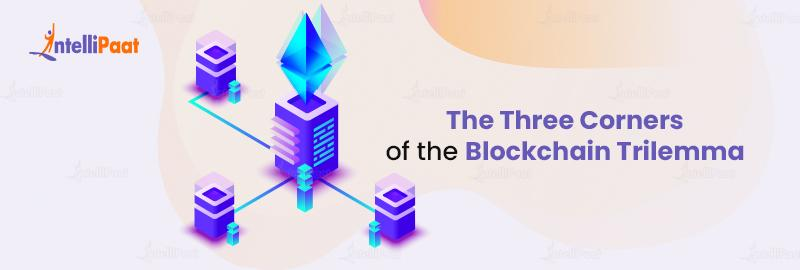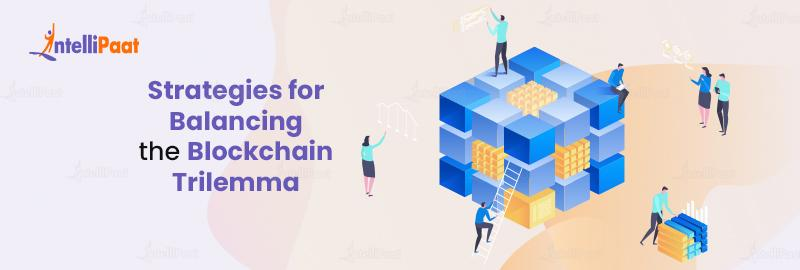What is the Blockchain Trilemma?
We will thoroughly examine the blockchain trilemma in this post, from its inception to its effects on advancing blockchain technology. Join us as we explore this challenging but exciting issue and see how it influences the blockchain industry’s development.
- Introduction to Blockchain Trilemma
- Three Corners of Blockchain Trilemma
- Importance of Blockchain Trilemma
- Strategies for Balancing the Blockchain Trilemma
- Examples of Blockchain Trilemma in Practice
- Future of Blockchain Trilemma
- Conclusion
Explore the world of blockchain technology with our expert-led video – click now to gain valuable insights with Intellipaat!
{
“@context”: “https://schema.org”,
“@type”: “VideoObject”,
“name”: “Blockchain Full Course | Blockchain Tutorial For Beginners | Intellipaat”,
“description”: “What is the Blockchain Trilemma?”,
“thumbnailUrl”: “https://img.youtube.com/vi/orexiRMFJqs/hqdefault.jpg”,
“uploadDate”: “2023-05-31T08:00:00+08:00”,
“publisher”: {
“@type”: “Organization”,
“name”: “Intellipaat Software Solutions Pvt Ltd”,
“logo”: {
“@type”: “ImageObject”,
“url”: “https://intellipaat.com/blog/wp-content/themes/intellipaat-blog-new/images/logo.png”,
“width”: 124,
“height”: 43
}
},
“contentUrl”: “https://www.youtube.com/watch?v=orexiRMFJqs”,
“embedUrl”: “https://www.youtube.com/embed/orexiRMFJqs”
}
Introduction to Blockchain Trilemma
The difficulty of achieving security, scalability, and decentralization—the three essential characteristics of blockchain technology—is known as “blockchain trilemma.” These three traits frequently compete with one another, so enhancing one results in the degradation of the other two. Blockchain academics and developers are attempting to overcome the blockchain trilemma, which is a big problem.
Three Corners of Blockchain Trilemma

Security, scalability, and decentralization comprise the three sides of the blockchain trilemma. The integrity of the blockchain network, as well as the security and immutability of the data and transactions recorded, depend on security. As blockchain technology spreads, scalability is crucial for enabling blockchain networks to accommodate an increasing volume of transactions. Decentralization is essential to shield the network from monopolistic control and to make it impervious to censorship and manipulation.
It is challenging to balance these three characteristics because enhancing one characteristic frequently degrades the other two. For instance, enhancing security on a blockchain network can necessitate giving up some degree of scalability or decentralization. Like the above, increasing scalability might necessitate giving up some degree of security or decentralization. Last but not least, expanding decentralization can necessitate compromising some level of security or scalability.
Despite these difficulties, blockchain researchers and developers constantly seek fresh approaches to resolve the blockchain trilemma. Blockchain technology can realize its full potential and revolutionize a number of industries by striking a balance between security, scalability, and decentralization.
Take the first step towards becoming a certified blockchain professional with our comprehensive Blockchain Course – enroll now with Intellipaat.
Importance of Blockchain Trilemma
Since it directly affects the usefulness and adoption of blockchain technology, blockchain trilemma is a crucial concern for the blockchain industry. In order to gain the consumers’ trust, security is crucial since it ensures that the data and transactions kept on the blockchain network are safe and secure. As scalability enables blockchain networks to accommodate a greater number of transactions, it is essential to increase the potential use cases of blockchain. Decentralization is essential to shield the network from censorship, manipulation, and control. Because no one organization controls a decentralized blockchain network, it is more democratic and secure against intrusions.
It is crucial to strike a balance in the blockchain trilemma. Nonsecure blockchain networks may cause users to lose faith in the network, which will prevent its adoption and usage. A blockchain network that is not scalable may restrict the technology’s possible use cases, which will make it less practical than more established centralized systems. Last but not least, a centralized blockchain network may be open to censorship and manipulation, which will negate the aim of blockchain technology.
Blockchain technology may realize its full potential and exert a transformational force across numerous industries by balancing security, scalability, and decentralization. The blockchain trilemma is a huge problem, but it also offers the blockchain sector a chance for innovation and advancement. Blockchain researchers and developers may realize the full potential of blockchain technology and build a safer, more open, and decentralized future by tackling this problem and coming up with fresh ways to balance the blockchain trilemma.
Strategies for Balancing the Blockchain Trilemma

Researchers and blockchain developers are approaching blockchain trilemma in a variety of ways. One tactic is to increase scalability while preserving security and decentralization by using layer-two scaling methods, like the Lightning Network. Sharding is a different tactic that divides the blockchain into more manageable chunks in order to increase scalability. To strike a compromise between security, scalability, and decentralization, a third tactic is to employ hybrid techniques, which incorporate the best features of various consensus algorithms. These tactics are crucial for resolving the blockchain trilemma and enabling blockchain technology to reach its full potential.
Examples of Blockchain Trilemma in Practice
Different blockchain networks, like Bitcoin and Ethereum, have faced considerable difficulties because of the blockchain trilemma. Bitcoin faces issues with scalability but offers a high level of security and decentralization. The Bitcoin network has grown more crowded due to the rise in transaction volume, which has led to delays and rising transaction costs. On the other hand, Ethereum has significantly improved scalability by utilizing layer-two scaling techniques like Optimistic Rollups. Some contend that this has come at the expense of decentralization, as the network is relying increasingly on a small number of powerful validators.
Despite these difficulties, academics and blockchain developers constantly look for fresh approaches to solve the blockchain trilemma. Sharding, which involves breaking the blockchain into smaller, easier-to-manage chunks, is one possible strategy. By allowing distinct nodes to manage various blockchain components, sharding can increase scalability while lowering the computational burden on individual nodes. Using hybrid consensus methods is an alternative strategy that combines the best features of many consensus mechanisms to strike a balance between security, scalability, and decentralization.
Boost your confidence for your next job interview with our expertly crafted top Blockchain Interview Questions and Answers.
Future of Blockchain Trilemma
New tactics and techniques are anticipated to develop as blockchain technology develops to balance security, scalability, and decentralization. Allowing users to perform transactions on the sidechain and settle them on the leading blockchain network, sidechains, and independent blockchain networks can help relieve scalability difficulties. Utilizing off-chain scaling techniques, like state channels, is another option for enhancing scalability without compromising security or decentralization. These techniques can lower the computing strain on the primary blockchain network.
In order to strike a balance between the three characteristics of blockchain trilemma, blockchain developers and researchers are also investigating novel consensus algorithms, such as Proof of Stake (PoS) and Proof of History (PoH). PoS and PoH strive to balance security, scalability, and decentralization by employing various methods of consensus. PoH employs a cryptographic clock to arrange transactions, which require less processing power, while PoS uses a stake-based approach, where validators are chosen based on how much cryptocurrency they own. By putting these ideas into practice, blockchain technology can help various industries by becoming a safer, more open, and more decentralized solution.
Begin your journey with Intellipaat’s beginner-friendly Blockchain Tutorial – click now to start learning.
Career Transition
Conclusion
The blockchain trilemma poses a serious obstacle for blockchain technology but also offers a window of opportunity for advancement. Unlocking the full potential of blockchain technology and building a more secure, open, and decentralized future depend on striking a balance between security, scalability, and decentralization. Understanding the blockchain trilemma and the various approaches to solving it will help us overcome this obstacle and advance the blockchain sector.
Join the Intellipaat Community today and connect with like-minded learners and industry experts to accelerate your career growth – click now to join!
The post What is the Blockchain Trilemma? appeared first on Intellipaat Blog.
Blog: Intellipaat - Blog
Leave a Comment
You must be logged in to post a comment.












